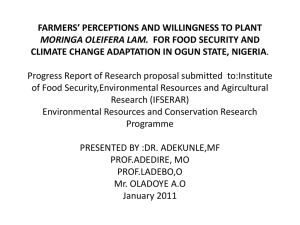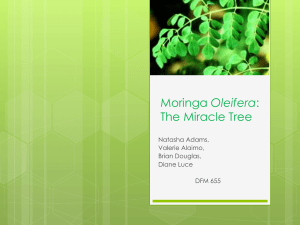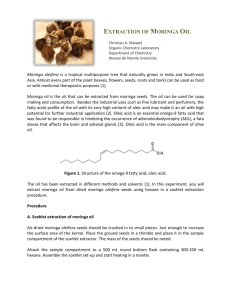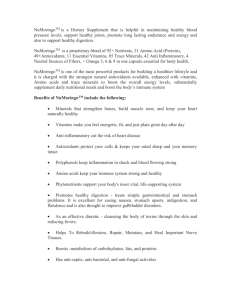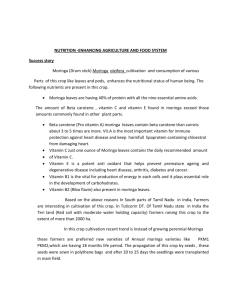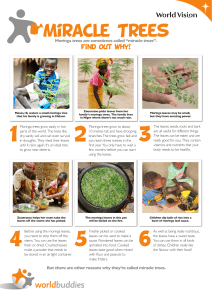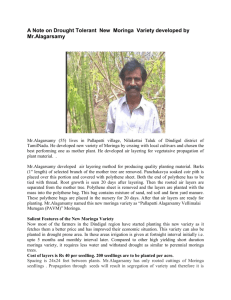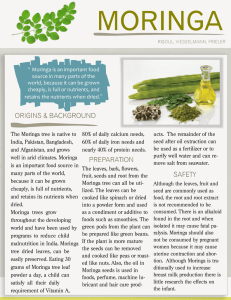Document 14105923
advertisement
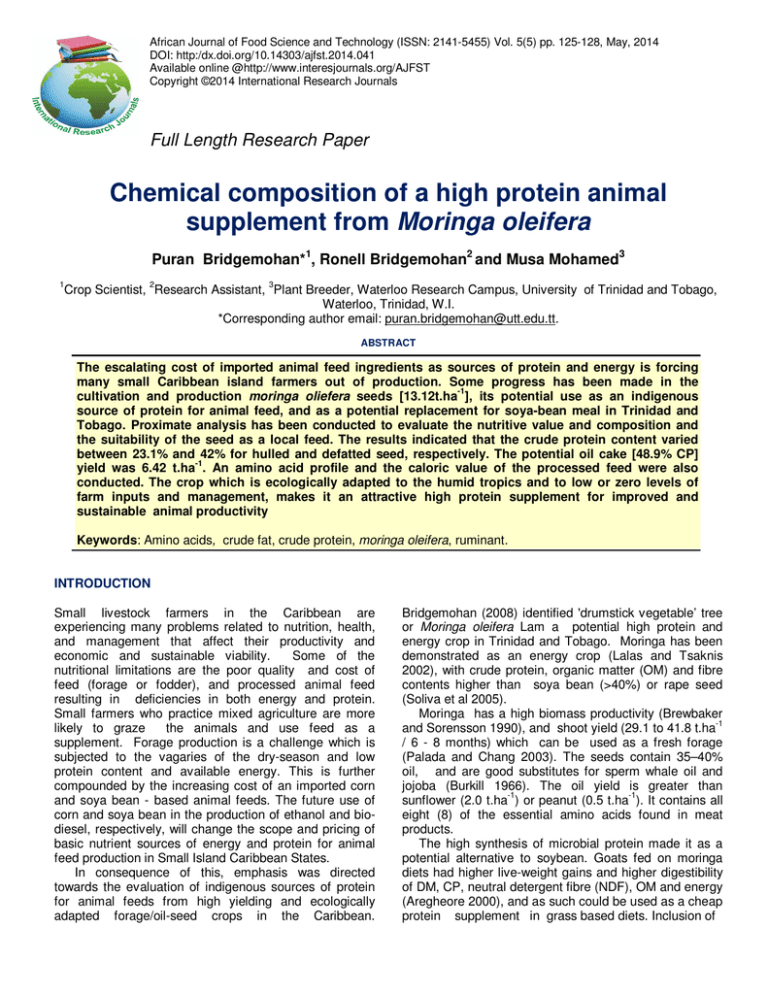
African Journal of Food Science and Technology (ISSN: 2141-5455) Vol. 5(5) pp. 125-128, May, 2014 DOI: http:/dx.doi.org/10.14303/ajfst.2014.041 Available online @http://www.interesjournals.org/AJFST Copyright ©2014 International Research Journals Full Length Research Paper Chemical composition of a high protein animal supplement from Moringa oleifera Puran Bridgemohan*1, Ronell Bridgemohan2 and Musa Mohamed3 1 2 3 Crop Scientist, Research Assistant, Plant Breeder, Waterloo Research Campus, University of Trinidad and Tobago, Waterloo, Trinidad, W.I. *Corresponding author email: puran.bridgemohan@utt.edu.tt. ABSTRACT The escalating cost of imported animal feed ingredients as sources of protein and energy is forcing many small Caribbean island farmers out of production. Some progress has been made in the cultivation and production moringa oliefera seeds [13.12t.ha-1], its potential use as an indigenous source of protein for animal feed, and as a potential replacement for soya-bean meal in Trinidad and Tobago. Proximate analysis has been conducted to evaluate the nutritive value and composition and the suitability of the seed as a local feed. The results indicated that the crude protein content varied between 23.1% and 42% for hulled and defatted seed, respectively. The potential oil cake [48.9% CP] yield was 6.42 t.ha-1. An amino acid profile and the caloric value of the processed feed were also conducted. The crop which is ecologically adapted to the humid tropics and to low or zero levels of farm inputs and management, makes it an attractive high protein supplement for improved and sustainable animal productivity Keywords: Amino acids, crude fat, crude protein, moringa oleifera, ruminant. INTRODUCTION Small livestock farmers in the Caribbean are experiencing many problems related to nutrition, health, and management that affect their productivity and economic and sustainable viability. Some of the nutritional limitations are the poor quality and cost of feed (forage or fodder), and processed animal feed resulting in deficiencies in both energy and protein. Small farmers who practice mixed agriculture are more likely to graze the animals and use feed as a supplement. Forage production is a challenge which is subjected to the vagaries of the dry-season and low protein content and available energy. This is further compounded by the increasing cost of an imported corn and soya bean - based animal feeds. The future use of corn and soya bean in the production of ethanol and biodiesel, respectively, will change the scope and pricing of basic nutrient sources of energy and protein for animal feed production in Small Island Caribbean States. In consequence of this, emphasis was directed towards the evaluation of indigenous sources of protein for animal feeds from high yielding and ecologically adapted forage/oil-seed crops in the Caribbean. Bridgemohan (2008) identified 'drumstick vegetable’ tree or Moringa oleifera Lam a potential high protein and energy crop in Trinidad and Tobago. Moringa has been demonstrated as an energy crop (Lalas and Tsaknis 2002), with crude protein, organic matter (OM) and fibre contents higher than soya bean (>40%) or rape seed (Soliva et al 2005). Moringa has a high biomass productivity (Brewbaker and Sorensson 1990), and shoot yield (29.1 to 41.8 t.ha-1 / 6 - 8 months) which can be used as a fresh forage (Palada and Chang 2003). The seeds contain 35–40% oil, and are good substitutes for sperm whale oil and jojoba (Burkill 1966). The oil yield is greater than sunflower (2.0 t.ha-1) or peanut (0.5 t.ha-1). It contains all eight (8) of the essential amino acids found in meat products. The high synthesis of microbial protein made it as a potential alternative to soybean. Goats fed on moringa diets had higher live-weight gains and higher digestibility of DM, CP, neutral detergent fibre (NDF), OM and energy (Aregheore 2000), and as such could be used as a cheap protein supplement in grass based diets. Inclusion of 126 Afr. J. Food Sci. Technol. Table 1. Percentage oil extracted from moringa seeds using hydraulic and screw press method Oil Extraction Method (w/w%) Treatments Fully De-hulled Partial De-hulled Un-hulled Hydraulic Press 29 25 3.4 moringa as a protein supplement in low quality diets was observed to improve the DM intake and digestibility of the diet and increased milk production without affecting affect milk composition (Reyes et al 2006). It has neglible contents of tannins and other anti-nutritional compounds and offers an alternative source of protein to ruminants (Makkar and Becker 1996). Apart from its suitability as animal feed, raw moringa leaf meal could replace about 30% of a fishmeal-based dietary protein in tilapia feeds (Afuang et al 2003). The leaf meal was evaluated as an alternative protein source for Nile tilapia, and recommended as a for substitute up to 10% of dietary protein without significant reduction in growth. The role of legume forage and seeds as a source of both energy and protein in livestock feeds has been well reviewed (Tothill 1986), but more work on indigenous legumes species such as moringa is still required in the Caribbean. The advantage of moringa is that it is high yielding, ecologically well established on marginal soils in the Caribbean, and do not compete for arable lands, crop nutrient, water or specialized equipment or husbandry (Bridgemohan 2008). Moringa yields are more than 50% higher than soya bean (Ermoneit 1973). The aim of this study was to evaluate moringa as a sustainable high crude protein supplement for animal feed in the Caribbean, and to promote its inclusion in low quality diets in ruminants. MATERIALS AND METHODS This study was conducted at the Waterloo Research Facilities, University of Trinidad and Tobago, during the period April, 2010 to February, 2013. Dry pods of moringa were harvested from the Station’s research Plot and air-dried until the seed moisture content was reduced to 12 to 14%. The seeds were removed from the pod and further sun-dried for 48 hours after which they were cleaned and/or dehulled and aspirated manually and separated into 3 categories: 1. Whole grain – whole kernel not crushed 2. De-hulled – kernel only, but subjected to full or partial crushing 3. Un-hulled – all external shells or testa retained, and subjected crushing. The seeds [1kg samples at 10% MC] were de-fatted or the oils extracted by press method (Weiss 1971) or hot water treatment. The two (2) press extraction methods are: Screw Press 47 23 12 Mean 38 24 8 S.D. 12.5 1.5 6.1 1. Hydraulic Press [Carver Laboratory Equipment, Model #3925 @ 2500psi], and, 2. Screw Press [Electrolux Extruder with heater, Model#N24@ 400W ] The hot water extraction was conducted on both dehulled and unhulled seed (250g), and the ground treatment done using a hand mill (1.0mm particle size). The material was boiled in 1l of water for 5 minutes, and then strained. The extractant was chilled at 5oC for 72hrs and the solid residue oven-dried at 100oC for 72 hrs for nutrient analysis. All extractions were done in 3 replicates. Proximate analyses were conducted according to AOAC for DM, ash, CP, crude fibre (CF) and ether extract (AOAC, 1984), for NDF (Goering and van Soest, 1970), and for ADF (Van Soest et al 1991). The Amino Acid Profile (Spackman et al 1959) was conducted using the Technicon Sequential Multi-sample (TSM) amino acid analyzer(DNA0209) .Both analyses were conducted at the West Virginia University USA. All data were subject to preliminary statistical analysis. RESULTS AND DISCUSSION The seed -oil yields after treatments indicated that more oil was extracted from the fully and partial de-hulled seeds for both method of pressing (Table 1). However, the screw press extracted significantly more oil (40%) than the mechanical press for the fully de-hulled. This could be accounted for the fact that the screw press has a heating element (400W) and the crushed particles are more pulverized and finer. The hydraulic press has limitations, in that the holes are not at the bottom of the cylinder, but at the sides, thus at least 25% of the sampled by volume retain oils which are not easily pressed oil. The level of oil remaining in the pressed cakes or pellets result affects the % crude fat during the proximate analysis. The hot water extraction produced 10ml of oil per 250 g sample for the ground seeds and 50 % less for the whole seeds. The nutrient analyses for the varying treatments are presented in Table 2. All the analysis was conducted between 5 to 9.9% MC. The results indicated that the mean Crude Protein (CP) was 35.7%, and the defatted x dehulled treatment yield 45.28%. However when the seeds were defatted or oils extracted, the CP increased by 20 to 40%. The % crude fat (CF) varied between defatted (17.15%) or whole grain (38.19%).The crop is an oil-seed plant has both a high oil (38%) and crude protein (45%) content. However, the presence of hull Bridgemohan et al. 127 Table 2. Proximate analysis of moringa seeds (w/w%)) under varying treatments. Proximate analysis Whole grain Crude Protein Defatted partial 37 Dehulled 45 Unhulled 40 defatted 34 dehulled 32 Moisture 5 7 7 6 10 Crude Fat 38 25 17 22 30 Crude Fiber 3 3 24 16 18 Ash 4 4 4 5 5 X [ SD] 36 [4.98] 7 [1.30] 26 [6.90] 13 [8.81] 5 [0.75] Table 3. Amino acids [%] profile moringa seeds under varying treatments Amino Acids Whole grain Defatted Partial Dehulled Unhulled defatted dehulled Aspartic Acid 1.5 1.8 1.4 1.4 1.6 Threonine 0.8 0.9 0.6 0.6 0.8 Glutamic Acid 7 8.5 5.7 4.2 7.4 Proline 1.7 2.1 1.5 1.3 1.8 Glycine 1.8 2.2 1.5 1.2 1.9 Alanine 1.4 1.7 1.1 1.1 1.5 Cysteine 1.5 1.8 1.2 0.9 1.5 Valine 1.3 1.6 1.1 1.1 1.4 Methionine 0.7 0.8 0.5 0.5 0.7 Isoleucine 1.1 1.4 0.9 0.9 1.2 Leucine 1.9 2.4 1.6 1.4 2.0 Lysine 0.5 0.6 0.6 0.5 0.6 X [SD] 1.8 [1.37] 21 2.1 [0.99] 26 1.5 [1.44] 18 1.3 [1.81] 15 1.9 [1.28] 23 Total appears to be absorbing some fat, thus accounting for the low CF in the defatted-un-hulled treatment. As is expected, the un-hulled treatment produced the highest Crude Fibre. There was no significant difference on Ash Content between treatments. The total amino acid content of the seed were generally high and varied between 15 to 25 % for the varying treatments (Table 3). The hot water method of extraction is unsatisfactory and inefficient, and it suggested that the crushed material be heated prior to extraction to increase oil yield (Kakengi et al 2005). The analysis did not indicate that the extraction of the oil had any influence on CP yield. The yields of CP and CF for the undefatted were similar to that reported by Bridgemohan (2008), Anhwange et al (2004) and Ramachandran et al (1980). Duke (1983) reported that moringa cakes after oil extraction [40%] contained 58.9% CP. Defatted moringa seed meal has the potential to increase rumen fermentation, and lamb -1 growth rates increased by 63 to 76 g,day (Ben Salem et al 2008). Sarwant et al (2002) and Noula (2004) found that crude protein from leaves can replace other sources of concentrated protein by 50% without affecting rumen activity. The analysis revealed that moringa can be a good source of essential amino acids which are all contained in a appreciable quantities (Ram 1994), and can serve as equally good source of amino acids for man and livestock(Anhwange et al 2004). Based on the CP requirements (Folkland and Sutherland, 2008) for chickens [22% CP], fattening pigs [12-14% CP] , and lactating cow [16-18% CP], moringa seed cake appears to have good potential to be an alternative source of protein for both ruminant and non ruminant production in the Caribbean, and to be used to supplement diets based on crop residues / poor roughages. 128 Afr. J. Food Sci. Technol. Globally, the use of soya bean in animal feed and is expected to increase 5%.yr-1 for the next ten (10) years [USDA 2002]. The price of coarse grains will plummet as ethanol production increases, and China becomes a net importer of corn. The effect will be more pronounced in W. Europe where legal restrictions have virtually eliminated the use of animal proteins from feeds. Transgenic crops will gain global acceptance in the future, and alternative sources of crop protein will be demanded. Those crops with increased energy and protein digestibility are most likely to be successful to fill this nutrient gap, and Crop scientist and Animal Nutrition Scientist will be challenged to extract more available nutrients from indigenous crops top produce high value feed ingredients [Swick 2008]. CONCLUSION This exploratory studies has revealed that moringa is indigenous and ecologically adapted crop to marginal soils and crop management and 50% more productive than soya bean It has high energy values and can be a significant source of high crude protein supplement for small ruminant and non - ruminants. Additionally, the preliminary studies at the UTT have indicated that the oil is a potential source of cheap bio-fuel for farm mechanization and rural electrification. REFERENCES Afuang W, Siddhuraj P, Becker K(2003). Comparative nutritional evaluation of raw, methanol extracted residues and methanol extracts of moringa (Moringa oleifera Lam) leaves on growth performance and feed utilization in Nile tilapia (Oreochromis niloticus L.), Aquaculture Research 34: 1147-1151 Anhwange BA, Ajibola V O, Oniye(2004). Amino acid composition of seed of moringa oleifera, detarium microcarpum, and bauhinia monandra. ChemClass Journal: 9-13. Anon. 2008. Moringa seeds as biofuel stock in Mara EI 2008 http://www.alternative.com.biofuel Aregheore EM(2000). Intake and digestibility of Moringa oleifera–batiki grass mixtures by growing goat. Small Ruminant Research 46: 23 28. Association of Official Analytical Chemist. 1984. Official Method of th Analysis, 14 Edition, AOAC, Arlington, VA, USA. Ben Salem H, Makkar HPS(2008). Defatted moringa oliefera seed meal as a feed additive for sheep. Animal Feed Science 10:10-16 Brewbaker JL, Sorensson CT(1990). New tree crops from interspecific Leucaena hybrids. In: Janick, J. and Simon, J.E. (eds), Advances in New Crops, Timber Press, Portland, pp. 283-289. Bridgemohan P(2008) Moringa oleifera – an underexploited source of th crop protein in the Caribbean. The 16 Caribbean Academy of Sciences Biennial Conference on Science and Technology: vehicles for sustainable Development in the Caribbean. Pp.246-249. Ermoneit M(1973). The growing of Soyabean Chaguaramas Agricultural Development Project. Crop Bulletin 23– Ministry of Agriculture Land and Fisheries, Trinidad and Tobago Folkard G, Sutherland J(2008). Moringa oil. http:/tilz.tearfund.org / Moringa oil.htm Goering HK, Van Soest PJ(1970). Forage Fibre Analysis, USDA. Agricultural Handbook, Vol.379, USDA, Washington DC Jahn S AA, Dirar H (1979) . Studies on natural coagulants in Sudan, with special reference to Moringa oliefera seeds, Water, 5: 90-97 Kakengi AMV, Shem MN, Sarwatt SV, Fuihara T(2005). Ca Moringa oleifera be used as a protein suppoement for ruminants? Asian – Australian Journal of Animal Sciences. 18, 42-47. Lalas S, Tsaknis J(2002). Characterization of Moringa oleifera Seed Oil Variety Periyakulam. Journal of Food Composition and Analysis 15: 65-69. Makkar HPS, Bekker T(1996).. Nutritional value and anti-nutritinal componenets of whole and ethanol extracted moringa oliefera leaves. Animal Feed Science Technology 63: 211-228. Noula FS (2004). The comparison of plant cell wall degrading in the rumen. Unpublished Ph. D. Thesis, University of Hohoheim Institute, 480. Palada MC, Chang LC(2003). Suggested cultural Practices for Moringa. International Co-operators Guide, AURDC pub. # 03-545. Palaniswamy UR (2004). Purslane – Drumstick. Asian American Studies Institutes, School of Allied Health, University of Connecticut, Storrs; http://www.lokvani.com. Ram J (1994). Moringa : A highly nutritious vegetable tree. Trades Technical Bulletin No.2 Ramachandran C, Peter KV, Gopalkrishnan PK(1980). Drumstick (Moringa oliefera): a multipurpose Indian vegetable. Econ. Bot. 34:276-83. Reyes S, Nadir S , Eva L(2006) Comparative nutritional evaluation of raw, methanol extracted residues and methanol extracts of moringa (Moringa oleifera Lam.) leaves on growth performance and feed utilization in Nile tilapia (Oreochromis niloticus L.). Livestock Science, 101:24-31. Soliva C R, Kreuzer M, Foidl N, Machmüller A , Hess HD(2005). Feeding value of whole and extracted Moringa oleifera leaves for ruminants and their effects on ruminal fermentation in vitro. Animal Feed Science & Technology 118: 47-62. Spackman D H, Stein E H, Moore S(1959) Analytical Chemistry, 30: 1190-1191. Swarwatt S V, Dapange S S, Dadengl A V(2002). Substituting sunflower seed-cake with Moringa Oleifera leaves as a supplemental goat feed in Tanzania. Agro-forestry systems. 56: 214-24 Swick R A(2006). Will the Global supply of nutrient continue to meet the demands of the feed industry?” World Food Nutrition Forum, BIOMIN.http.//www.ergrmix.com. Tothill J C(1986). The role of forage legumes in Farming systems. Proceedings of Workshop held at ILCA. Addis Ababa, Ethiopia, 1619 Sept, pp 162-185. Van Soest P J, Patterson J B , Lewis B A(1991). Symposium: Carbohydrate Methodology, metabolism, and nutritional implication in dairy cattle. Methods for dietary fibre neutral detergent fibre and non-starch carbohydrate in relation to animal production. J. Dairy Science 7: 3583-3597. Weiss E A .1971. Castor, Sesame, and Safflower. Leonard Hill, London. How to cite this article: Bridgemohan P., Bridgemohan R. and Mohamed M. (2014). Chemical composition of a high protein animal supplement from Moringa oleifera. Afr. J. Food Sci. Technol. 5(5):125-128

